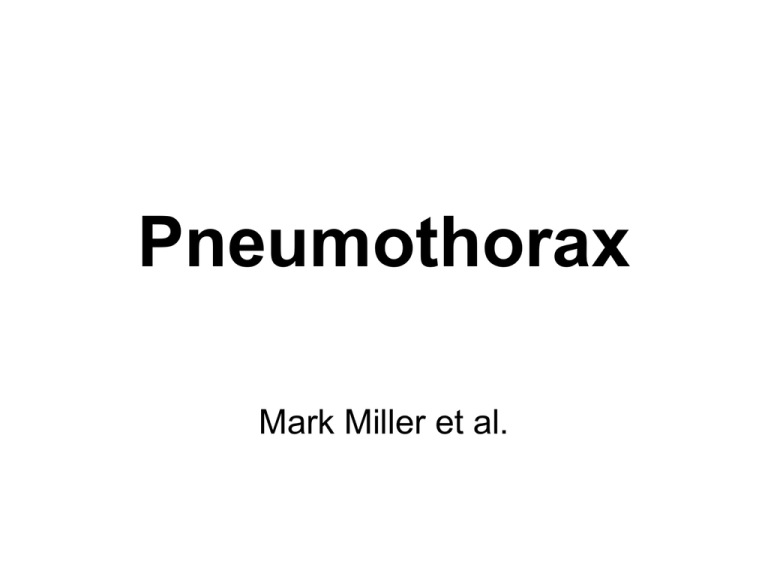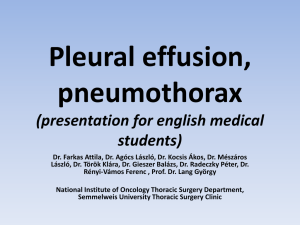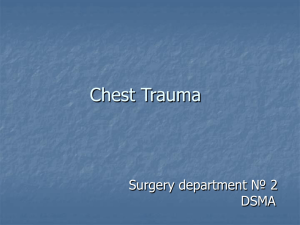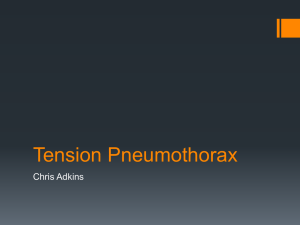Spontaneous Pneumothorax
advertisement

Pneumothorax Mark Miller et al. Outline • • • • • • Classification of Pneumothoraces Epidemiology & Pathophysiology Diagnosis Guidelines & Evidence Management options Summary Case • 21 year old man presents to ED with left sided respirophasic chest pain. • Differential diagnoses? Case • 21 year old man presents to ED with left sided respirophasic chest pain. • Differential diagnoses? • • • • • • Chest wall Pleura Lung Pericardium Mediastinum Neuropathic Case • Other important history? Case • Other important history? • Physical Examination? Case • Other important history? • Physical Examination? • Investigations? Case • What’s the plan? Case • What’s the plan? – Do an invasive procedure? – Do “nothing”? Day 5. Classification of Pneumothorax Spontaneous; • Primary spontaneous PMTX - occurs in people without clinically apparent lung disease (subpleural blebs & bullae) • Secondary spontaneous PMTXoccurring as a complication of preexisting lung disease (esp COAD) Classification of Pneumothorax Other; • Iatrogenic (procedural- lines & biopsies) • Traumatic (Penetrating, blunt, barotrauma) • Non-Pulmonary in origin (Boerhaave’s, Catamenial, 2o to pneumoperitoneum) Pathophysiology • Lung tissue breach, air enters pleural space (negative pressure), intra-pleural pressure equilibrates with intra-bronchial pressure. • Unventilated segments create a shunt and potentially hypoxia. • Tension PMTX is due to “Flap-valve” effect, mediastinal shift distorts great vessels, reduces VR and causes hypotension. Symptoms and signs. • Primary; – often occur at rest with ispilateral pain or acute SOB – symptoms may resolve within 24 hrs – small PTX (<15%) may have no signs, large PTX classic signs. Tachycardia is common. – ABG may show ⇑ A-a gradient and acute respiratory alkalosis Symptoms and signs. • Secondary; – Small PMTX often badly tolerated in severe CAL- potentially life-threatening. – SOB and hypoxia often disproportionate to size of PMTX. Most have ipsilateral Pain – Signs often subtle & masked by underlying disease – hypercarbia often occurs Symptoms and signs. • Signs include: – Asymmetrically decreased breath sounds – Hyperresonance – Altered vocal resonance – Often chest examination is unremarkable – Less commonly: Hamman’s crunch or Surgical emphysema – Tracheal deviation & shock= ?Tension pneumothorax Complications. Acute; • Tension pneumothorax • Sc emphysema • Pneumomediastinum/ pericardium Delayed; • Failure to rexpand • Recurrence Diagnosis CXR • PA erect CXR will demostrate 83% • routine use of expiratory films doesn’t increase yield (?useful for small apical PTX). • Hyperlucency, lack of peripheral markings, fine visceral pleural line paralleling chest wall, blunted CP angle • lat. decubitus view may be helpful • supine films, PMTX easily missed - deep sulcus (CP angle) Diagnosis • Estimating size of PTX is challenging and unecessary; • Small= <2cm between lung and chest wall • Large= >2cm between lung and chest wall The Supine Film CT may be used to differentiate PMTX from bullae Treatment Options • Depends on pneumothorax size, symptom severity, co-morbidities, resources and patient preferences: Observation (& Oxygen) Aspiration Intercostal tube drainage Referral to specialists (physicians/surgeons) Guidelines. • BTS • ACCP Thorax 2003;58(Supp II):ii39-ii52 Chest 2001; 119:590-602 Figure 1 Recommended algorithm for the treatment of primary pneumothorax. Figure 2 Recommended algorithm for the treatment of secondary pneumothorax. Evidence? • This is a data-poor area • Cochrane RV; Simple aspiration vs ICC for PSP 2007. • Based on 6 studies only, numbers are small, one RCT only (n=60)!!! • There is no significant difference in outcome success • Aspiration may reduce hospitalisation. Evidence? • BMJ Evidence Review; • Small tubes are easier to insert but large PMTX may not respond. • Suction? Studies are too small and underpowered to show any benefit. • Optimal timing of pleurodesis is unclear. Observation. • Sensible pts living close with small (<2cm) PSP who have minimal symptoms may be discharged with early outpatient review (?re X-Ray in ED at 24 hrs and 7days). • These patients should be advised that they should return in the event of worsening breathlessness or pain (no flying or diving). • up to 40% require further drainage Denitrogenation... • Whilst in hospital (ED or ward) give high flow oxygen (10 L/min, not for COAD). • Resorption is 2% per day on room air – supplemental oxygen increases this rate 4-fold (Northfield TC BMJ 1971 –n=22) in humans plus several animal models. Simple Aspiration • Big advantages… • Easier, less painful, involves fewer complications and may allow discharge home (fewer hospital days) • NB; there are small catheters that can be used for aspiration followed by UWSD if necessary. Simple Aspiration • First line treatment for all primary pneumothoraces requiring intervention (5983% success rate). • Only recommended as an initial treatment in small (<2cm) secondary pneumothoraces in minimally breathless patients under the age of 50 years (or as a temporary manoeuvre in the anticoagulated). Simple Aspiration • Use a seldinger kit (custom pigtail or CVL) and a 60mL leur lock syringe with a 3-way tap (avoid cannulas). • Aspirate until discomfort is felt, patient coughs, no more air aspirated , or 3L aspirated (leave catheter in situ) • Re-Xray now and at 6 hours Simple Aspiration • What is success? Reduction to < 20% maintained at 6 (?) hrs. • If successful, re-Xray at 6 hours then discharge to follow up (back in 24hrs for X-ray then 7 days) • Admit successfully aspirated SSP Simple Aspiration • Immediate failure - no/minor improvement. (if >2.5L aspirated then failure likely) • ? Role of repeated attempt (up to 20% success quoted) Simple Aspiration In whom is aspiration less likely to be sucessful? • Large PMTX- some studies report correlation with size (82% success with moderate vs 43% with large- Aplin Emerg Med 1996) • Secondary PMTX • ? Earlier presentation • Age >50yrs Simple Aspiration Pleurocath CVL Cannula Simple Aspiration 14Fr Seldinger Pigtail catheter Intercostal catheter drainage When? • If simple aspiration fails in PSP. • Secondary pneumothorax (except small PMTX in <50yrs). • Mechanical/NI ventilation planned. • Significant fluid/blood collection • Tension PMTX • Bilateral PMTX • Air transport planned • Recurrence if chemical pleurodesis planned Intercostal catheter drainage What Size? • There is no evidence that large tubes (20-24F) are any better than small tubes (10-14F). • The initial use of large tubes is not recommended, although it may become necessary if there is a persistent air leak. Intercostal catheter drainage Methods • A brutal, torturous procedure in the wrong hands. • Seldinger style tubes. • Blunt dissection- finger into pleural space NO TROCAR! • Use maximum volume of LA allowable and infiltrate en route through the chest wall. • Use morphine and sedation if possible • In most adults a depth of >12cm at skin is required. Intercostal catheter drainage ICC Care; • Suture securely and tape joins well • admission until lung completely expands + bubbling ceases for 24 hrs. • Suction should not be routinely applied. • 90% success for 1st SPTX, 52% for 1st recurrence, 15% for 2nd recurrence Complications. ICC Complications; • Subcutaneous placement • Inserted too far (painful) • sc emphysema • Haemothorax • Lacerated intrathoracic or intra-abdominal organs (heart, liver, colon, stomach…) • Empyema • Re-expansion pulmonary oedema • Kinking, dislodgement, clotting of tube Radiological Anatomy of an ICC Recurrences • Recur in 50% first episode and 60-70% subsequent episodes • Primary – in compilation of 11 studies after treatment with observation, catheter drainage or ICC the average recurrence was 30% (range 16-52%), most within 2 yrs. – Presence of bullae not predictive • Secondary – 39-47% recur Treating Recurrence • Chemical Pleurodesis – If unwilling/unable to undergo surgery – talc, silver nitrate, tetracycline, minocycline – recurrence rate 8 - 25% – Painful Treating Recurrence • Thoracoscopy – Refer to surgeons after recurrence or if there is failure to re-expand. – Allows resection of bullae, mechanical pleural abrasion and talc insufflation – Recurrence rate is 2-14% Iatrogenic pneumothorax Management: • The majority will resolve with observation. • If required, treatment should be by simple aspiration. • Patient with COAD who develop an iatrogenic pneumothorax are more likely to require tube drainage. Traumatic pneumothorax . Traumatic pneumothorax Management: • Because of the associated risk of Haaemothorax and persistent leak a formal large bore (28-32Fr) ICC is recommended by most authorities. Tension pneumothorax Management: • ATLS recommends a 50mm catheter be placed 2ics-mcl. • Our 14G cannulae are 45mm long • A CT study of dead adult male soldiers showed a mean chest wall thickness at the recommended site to be 53mm! • Place a tube early as the cannula used for thoracentesis commonly kinks or dislodges. QUESTIONS? TAKE HOME • How would you like your PMTX managed? • Not all PMTX need a procedure. • Not all PMTX need admission. • Any procedural breach of the pleural space has a complication rateespecially when undertaken emergently. • NEVER USE THE TROCAR!!! TAKE HOME • Aspiration is simple and safe. • Aspiration is less painful, probably has fewer complications and reduces hospital admission. • Aspirated patients recur at the same rate as those who get an ICC. • If drainage is required then aspiration should be attempted first in most patients using a drainage kit that can be attached to an UWSD. TAKE HOME • Before committing a patient to an ICC & admission the Emergency & Respiratory physicians would like to discuss the options (we are generally conservative and not as driven by procedural greed as trainees).








